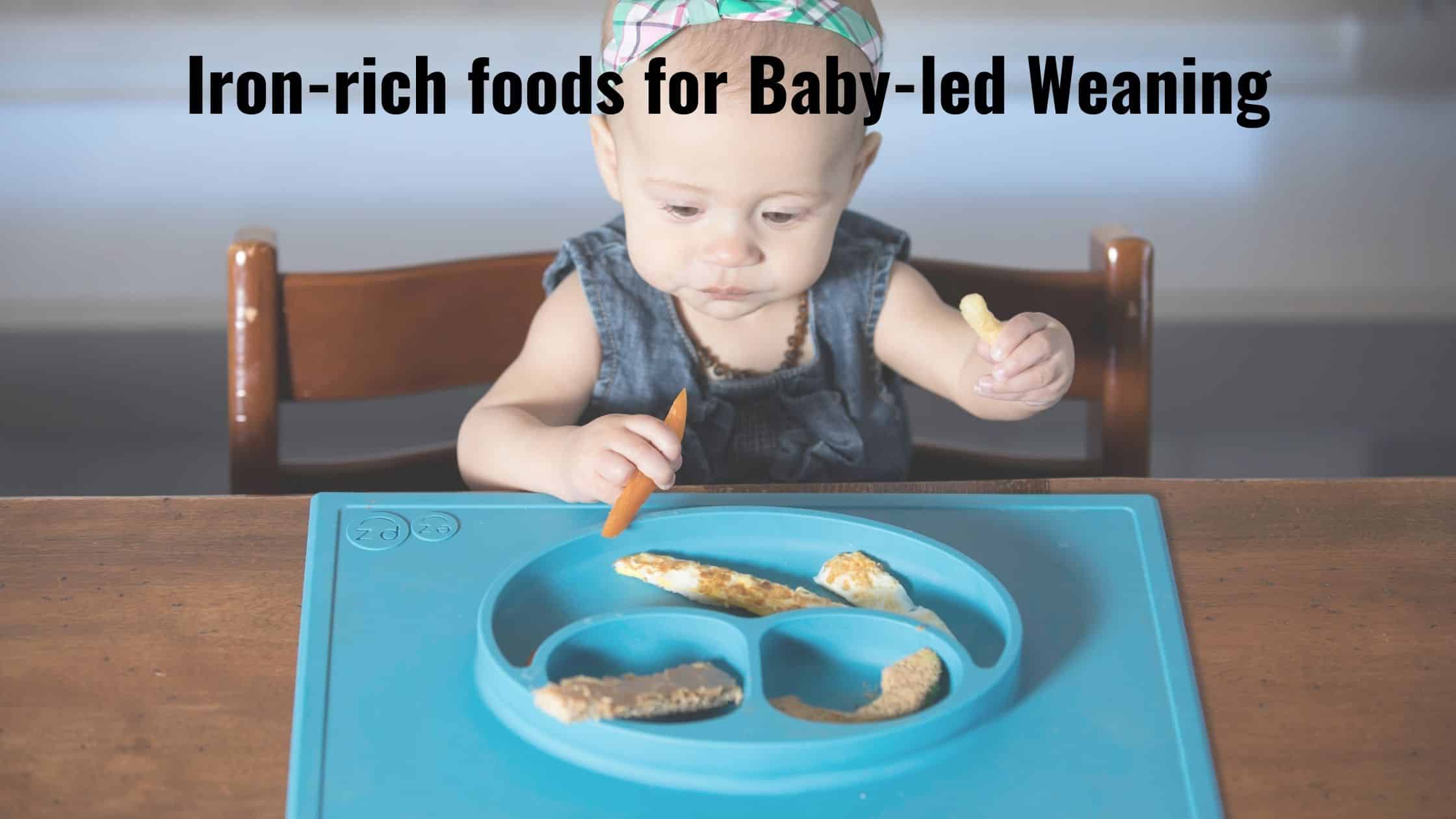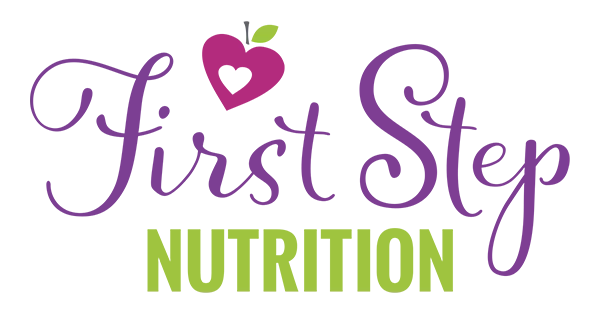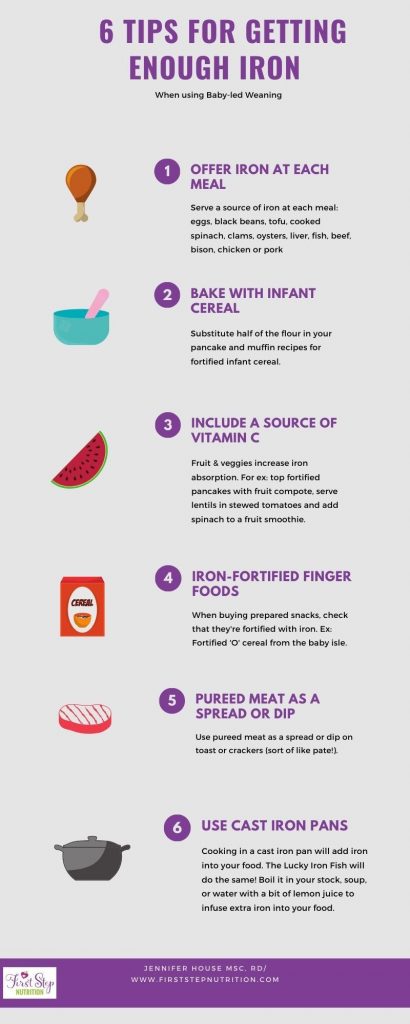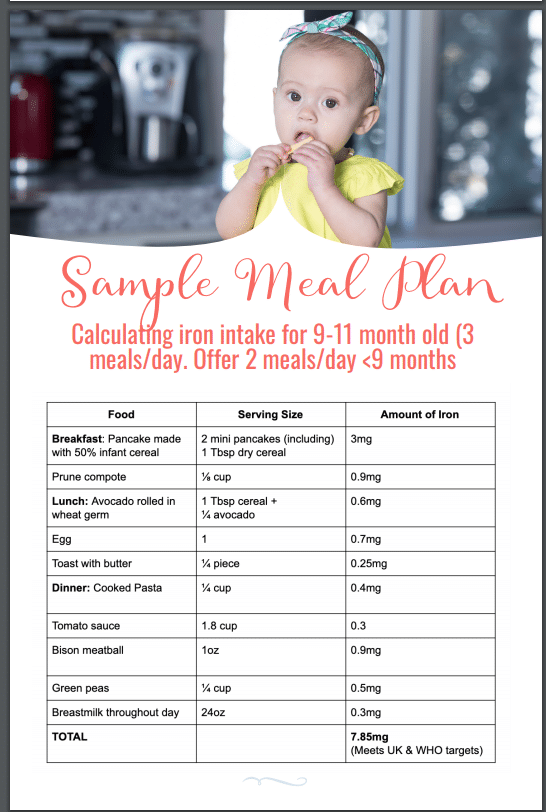
6 tips to getting enough Iron rich foods for baby led weaning
Learn all about why your baby needs iron, how much, signs of deficiency and how to offer iron-rich foods to your baby!
Are you starting your baby on solid foods with Baby-led Weaning?
Great, there are lots of benefits to baby-led weaning (BLW)! However one of health professionals’ main concerns is the perceived challenge of feeding your baby critical nutrients.
In this blog, I’ll share why iron is so important for your baby’s development, how much your baby needs and tips to ensure your baby gets enough iron-rich foods when starting solid with BLW.
Let’s dive into this guide to iron foods for babies.
Why is iron so important for baby?
This mineral is essential for body and brain growth, and deficiency is common.
One Canadian study tested 8 to 15-month-olds for blood levels. They found that 33.9% had iron deficiency and 4.3% had anemia (more severe deficiency).
One out of 3 of my kiddos was iron deficient. I didn’t find out until she was four years old, and I believe it affected her growth. That could be why she’s significantly shorter than the rest of our family!
Risks of iron deficiency anemia include irreversible physical and mental effects, like delayed attention and social withdrawal. So it’s always a good idea to test your baby’s levels around 12 months, and a supplement will be needed if they are low.
Is my baby at risk for iron deficiency?
From birth to 6 months, babies survive with their stores of iron built up during pregnancy. By six months, your baby’s stores from before birth start to run out. The amount of stores your baby has will depend on:
1. Mom’s blood iron levels in pregnancy. If the mom had low levels while pregnant, the newborn is more likely to have smaller iron reserves.
2. Gestational age at birth. Most of the baby’s iron stores are built up in the third trimester of pregnancy. Premature babies don’t benefit from this extra time to build full stores, so many require supplements. Finally, ONE benefit to those extra 17, 9 and 9 days I was “overdue” with my three babies!
3. How soon was the umbilical cord clamped? One study found that if a mother could wait for 3 minutes before cutting the umbilical cord (“delayed cord clamping”) at birth, her baby had higher iron stores at 4 months.
How much iron does my baby need?
The odd thing is that recommended intakes vary depending on where you live! In North America, the recommended intake is 11 mg daily from 6-11 months of age. As one comparison, the United Kingdom recommends an iron intake of 7.8mg/day for a 7-12-month-old.
The North American number is the recommended daily allowance (RDA) value set by the United States and Canada. The RDA is a “level sufficient to meet the nutrient requirements of 97 to 98% of healthy people within each age group.
But the 11mg per day goal assumes your baby is a vegetarian. Because the 11mg/day recommendation was calculated using an iron absorption rate of 10%. Yet for other age categories (assuming a mixed diet including some meat), an iron absorption rate of 18% was used.
Animal and plant-based sources aren’t absorbed equally. Heme iron from meat is absorbed 2x that of non-heme, found in fortified or non-meat (fortified & plant sources). More on that later…..but if you offer your baby heme iron, then 11mg daily is an inflated goal.
Phew!
Signs of iron deficiency in your baby
If you’re worried that your little one isn’t getting enough iron, here are some signs and symptoms of deficiency you can watch for:
- Slow weight gain
- Little appetite
- Pale skin
- Always tired
- Poor immunity (often sick).
With my daughter, I noticed her hair was relatively thin and fell out easily. This is a sign, too!
To prevent anemia, the American Academy of Pediatrics recommends that all 12-month-olds have a blood test to check their levels. If you’re worried about your child’s iron intake or they have some signs of deficiency, you’ll want to take them to the doctor and request a test.
You must supplement your child for a few months if levels are quite low. Food alone is unlikely to be enough to bring them up to normal.
Can Baby-led Weaners get enough iron?
Is it even possible to get adequate amounts of iron when using BLW? To find out, the Baby-led Introduction to Starting SolidS (BLISS) study looked at this. Two hundred families from New Zealand were split into either the BLISS group or the control group.
BLISS babies were taught to avoid choking, growth faltering, and getting enough iron-rich foods when self-feeding. They were encouraged to offer at each meal:
- High-iron food (focus on red meat and fortified cereals)
- Energy-rich food (i.e. cheese or avocado)
- Easy-to-eat food (i.e. fruit or veggie)
One of the studies published from the BLISS trial was titled “Impact of a modified version of baby-led weaning on iron intake and status: a randomized controlled trial.” Weighted 3-day diet records were used to examine nutrient intake at 7 and 12 months. A blood sample at 12 months was used to analyze the babies’ iron status.
Results found that 83% of babies in both groups had adequate iron levels, although 5% control and 7% BLISS had anemia. And there was no difference between the two groups at 7 or 12 months when comparing iron levels and stores. Or in iron intake from the diet, which was an average of 3mg per day at seven age months and 5mg at 12 months (way below RDAs of 11mg).
This is great news! With some extra education about safely practicing BLW, it can be a nutritious and safe method to start solids.
Iron-rich foods for baby-led weaning
While your baby’s main source of nutrition will still be breast milk or formula, it’s important to start getting iron from solid foods around six months. There are two types of iron present in food:
Heme iron is found in meat and fish. People usually absorb about 15 – 35% of the heme iron from food. This varies depending on your iron levels (you absorb more if you’re low). And dietary inhibitors (like phytates) and enhancers (such as vitamin C).
Heme sources
- Beef Liver (cooked) (1oz = 1.9mg)
- Bison (1oz = 1.1mg)
- Shrimp (1oz = 0.9mg)
- Beef (1oz = 0.8mg)
- Sardines (1oz = 0.8mg)
- Dark turkey meat (1oz = 0.7mg)
- Clams ( 1oz = 0.6mg)
- Chicken breast, pork or salmon (1oz = 0.3mg)
Note: While liver is an excellent source of iron, it contains too much preformed Vitamin A, which could be toxic. The Upper Limit recommended for ages up to 3 years is 600 micrograms. Just 1 oz of liver contains over 5,000 micrograms. Plus, the liver is the filter for our body, and it can also contain metals.
How to serve heme-iron to baby:
- Ground meat sauce
- Meatloaf meatballs or muffins
- Offer no-added salt canned fish like salmon as finger food or on toast.
- Pressure or slow-cooked pork or beef roast, shredded
- Ribs or chicken legs (removed of gristle) – also great pressure/slow-cooked
- Low-sodium canned salmon, sardines or clams
- Meat puree spread on toast strips
- Eggs fried and sliced in strips or scrambled. Or baked into these Sweet Potato & Breakfast Tortillas
- Salmon fish cakes
Non-heme sources
These are found in plants. Absorption levels are lower than heme-iron and vary from 2-5%.
- Fortified infant cereal (¼ cup = 3.7mg)
- Tofu (¼ cup = 3.3mg)
- Dried apricots (¼ cup = 1.9mg)
- Lentils (¼ cup cooked = 1.7mg)
- Hemp hearts (1 Tbsp = 1.4mg)
- Wheat Germ (1 Tbsp = 1.2g)
- Beans (¼ cup = 1mg)
- Blackstrap molasses (1 Tbsp = 0.9mg)
How to serve non-heme sources to baby:
- Grate firm tofu or slice it into thin strips. Blend soft tofu into smoothies for variety.
- Add blackstrap molasses to baking.
- Sprinkle wheat germ or hemp hearts on yogurt or blend into a smoothie.
- Serve hummus on a strip of toast. Black beans are a good finger food to practice the pincer grasp. Smush larger beans like kidney beans with your finger so they’re not a choking hazard.
Increasing iron absorption for baby
Where do parents go wrong when starting solids with Baby-led Weaning? It’s super-common just to offer fruits and veggies. And while nutritious, they don’t have enough calories or nutrients to be your baby’s primary food source (beyond breastmilk).
One good thing about fruits or veggies is that eating vitamin C and an iron source will boost absorption. You can find Vitamin C in fruits and veggies, such as citrus, berries, broccoli and bell peppers.
Luckily, it’s easy to pair vitamin C and iron sources, for example:
- a pasta sauce with ground meat and tomato sauce.
- infant cereal and berries.
- tofu veggie stirfry.
Tips to get enough iron for baby-led weaning
- Offer a source of iron-rich food at each meal (two times per day when starting): scrambled eggs, black beans, tofu, cooked spinach, clams, oysters, liver, fish, beef, and bison (higher in iron than beef!), chicken (dark meat is a better source than white) or pork.
- Offer fortified infant cereal baked into finger foods. You can also sub half of the flour in your pancake recipes for fortified infant cereal, like in this avocado blueberry muffin recipe.
- Include a source of vitamin C in the meal to increase absorption. Top fortified pancakes or cereal with fruit compote, serve lentils in stewed tomatoes and add spinach to a fruit smoothie.
- Cook with cast iron. Cast-iron pots safely add extra iron to the dishes cooked in them. If you don’t have one, you can add a product called Lucky Iron Fish.
- Use pureed meat as a spread or dip on toast or crackers (like pate!).
Iron-rich food for vegetarian babies
The official position of the Dietitians of Canada and the American Dietetic Association is that:
“Well-planned vegan, lacto-vegetarian, and lacto-ovo-vegetarian diets are appropriate for all stages of the life cycle, including pregnancy and lactation. Appropriately planned vegan, lacto-vegetarian, and lacto-ovo-vegetarian diets satisfy nutrient needs of infants, children, and adolescents and promote normal growth.”
Of course, the wider the variety of foods you can offer your baby, the easier it is to meet their nutritional needs. And there are some additional nutrients (omega-3 fats, zinc, calcium and vitamin B12) that you have to pay attention to when offering only plant-based foods. I have more information about this in my book The Parents’ Guide to Baby-led Weaning.
The American Academy of Pediatrics advises that babies take a dietary iron supplement starting at four months of age. And while this isn’t a worldwide recommendation, you may want to ask your doctor if she thinks a supplementation would be beneficial for your vegetarian baby.
Iron isn’t absorbed well from plant sources. That’s why vegetarians and vegans must pair a source of iron and foods with vitamin C at each meal.
And make sure to focus on offering an iron source at every meal, like eggs (for ovo-vegetarians), tofu, edamame, beans, lentils and hemp seeds.
Ways to use fortified infant cereal when baby-led weaning:
- Bake fortified infant cereals into finger foods for your beginning baby-led weaner.
- Roll slices of slippery fruit in the cereal (like banana or avocado). It makes it easier to grasp and adds iron!
- To self-feed cereal, offer your baby a “dipper” spoon, like Num Num Gootensils (affiliate link).
- Once your baby has developed a pincer grasp, try some of the fortified finger-friendly cereals in the baby-toddler food aisle of the grocery store.
Sample iron-rich meal plan for baby-led weaning
How does this all come together? Check out the meal plan below for an example of a day of iron-rich meals for babies.
For the pancakes and meatball recipes, grab my “7 Easy Baby-led Weaning Recipes Your Little One Will Love” here.
Founder of First Step Nutrition | Registered Dietitian Nutritionist
Jen believes raising happy, well-nourished eaters who have a healthy relationship with food doesn't have to be a battle! She is an author and speaker with 18 years of experience specializing in family nutrition and helps parents teach their kids to try new foods without yelling, tricking, or bribing.








No Comments